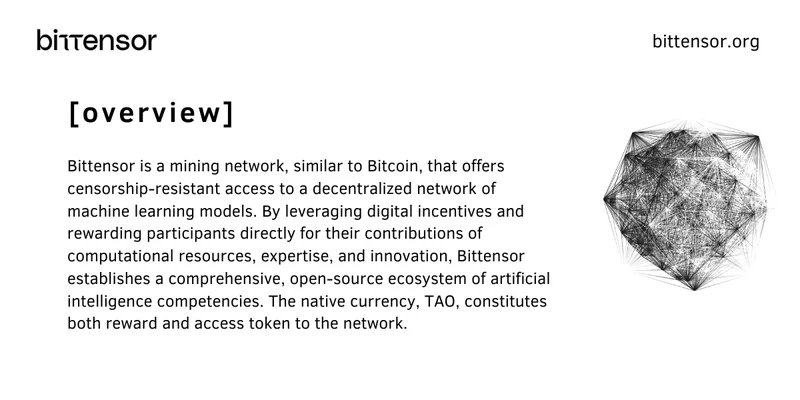So, Barry Silbert is back.
The man they once called a "founding father of Bitcoin investing" has decided to put his "business-building jersey back on," and he's got a brand new story to sell you. This time, it’s not just digital gold; it’s the "Bitcoin of AI." And honestly, if you're not at least a little suspicious, you haven't been paying attention.
Silbert, fresh from dragging his Digital Currency Group (DCG) through the mud of the crypto winter—complete with federal probes and fraud accusations—is now the CEO of Yuma. His new venture, Yuma Asset Management, just launched with a cool $10 million from daddy DCG, a New $10M Fund Aims to Power Bittensor’s Growing AI Network, to pour into something called Bittensor.
"I've not been as excited about anything since Bitcoin," he says.
Give me a break. We’ve all heard that line before. Every cycle, some crypto kingpin who just survived the last crash emerges from his bunker, points at a shiny new object, and declares it the second coming. It’s the oldest play in the book, designed to make you forget the recent past and FOMO into the glorious future.
The Wall Street Suit on the Crypto Beast
Let's be clear about what's happening here. Yuma Asset Management isn't some scrappy, grassroots fund. It's a calculated play to make a wildly speculative ecosystem look palatable for "venture-capital-like investors who can stomach a total loss." That’s a direct quote, by the way. They’re telling you upfront that your money could go to zero.
The whole setup is a masterpiece of financial theater. They’ve got two funds: one that’s like the "Nasdaq" (all the projects) and one that’s like the "Dow Jones" (the big boys). See what they did there? They used words your financial advisor understands to describe a chaotic, unproven digital frontier. It's like putting a bespoke Italian suit on a honey badger. It might look sophisticated at the investor meeting, but underneath it's still a wild, unpredictable beast with a nasty bite. Don't be fooled by the tailoring.

They want to make it "familiar and easy to understand" for institutions. Translation: they want to make it easy for big, dumb money to flow in without asking too many hard questions. But what exactly are they buying? Are these institutions aware that the Bittensor ecosystem is explicitly designed as a "Darwinian" deathmatch where a huge number of these projects, these "subnets," are engineered to fail? Who's cleaning up the mess when these subnets get "deregistered" for earning zero TAO? Are investors in the "Nasdaq" fund just buying a basket of lottery tickets, most of which are guaranteed losers?
Deconstructing the Hype Machine
So what the hell is Bittensor? It’s a "decentralized AI network." A bunch of mini-projects, or subnets, compete to build AI models, and the winners get rewarded in the native token, TAO. Some of these subnets are doing great, apparently delivering triple-digit returns. Others, like "Signal (SN100)" and "Eni (SN101)," are earning jack squat and circling the drain. It's a brutal, high-stakes game of natural selection.
And offcourse, there’s a halving coming. Just like with Bitcoin, the rate at which new TAO tokens are created is about to be cut in half. This is the scarcity narrative, the rocket fuel for every crypto bull run. Reduced supply, surging Google search trends, a supportive political narrative from the Trump administration... it’s the perfect storm of hype. They're selling scarcity, a halving, a 'Bitcoin of AI' story, and if you've been in this space for more than five minutes—
This whole thing ain't about technology, not really. It's about psychology. It’s about crafting a narrative so compelling that people ignore the flashing red lights. The story is that Bittensor is the people's AI, the decentralized answer to the corporate overlords at Google and OpenAI. A noble cause, sure. But how much of this is a genuine technological revolution, and how much is just a new, more complex way to speculate on tokens?
It’s an audacious move. No, "audacious" doesn't cover it—this is a five-alarm power play. Silbert and DCG weathered a storm that would have sunk lesser companies. They faced down regulators, angry creditors, and a market that had left them for dead. And now they’re back, not with a quiet, humble project, but with the loudest, most ambitious story they could find. You have to respect the sheer nerve. But is Silbert really back because he's found the next Bitcoin, or is this just the most convenient, high-octane narrative to rebuild an empire that was seriously shaken?
Then again, maybe I’m the crazy one. Maybe this really is the future. But when a man who just crawled out of a financial inferno tells you he’s found the next big thing and he’s packaged it just for you, you’d be a fool not to check where the fire exits are.
Same Circus, Different Clown Car
Let's cut the crap. This is a story as old as markets themselves. A powerful, well-connected player takes a highly volatile, complex, and risky asset class and repackages it for the mainstream. Barry Silbert is a master of this game. He’s not selling technology; he’s selling a story wrapped in a familiar financial product. Don't confuse the fancy fund structure with safety. It's a brilliant sales job, but it's still a sales job. You’re not investing in the next Bitcoin; you’re betting on Barry Silbert’s ability to convince everyone else that you are.
